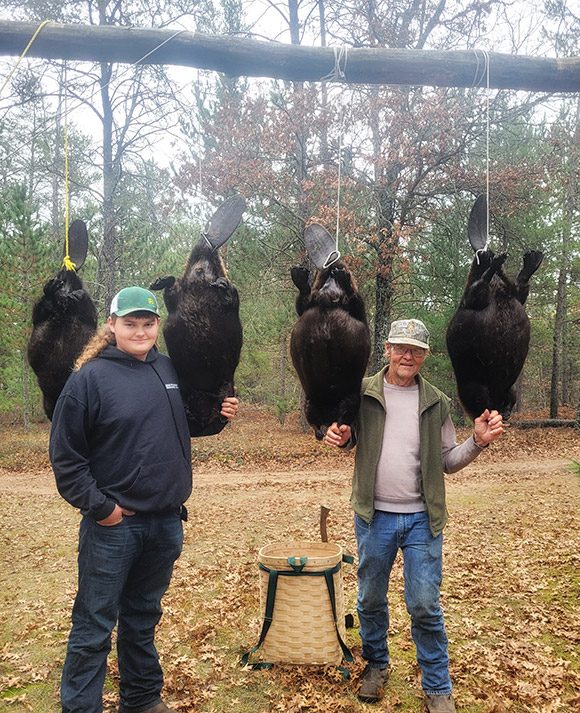 Team Fur News
Team Fur News
Looking Back, Looking Ahead
By FUR-FISH-GAME Editor, John D. Taylor
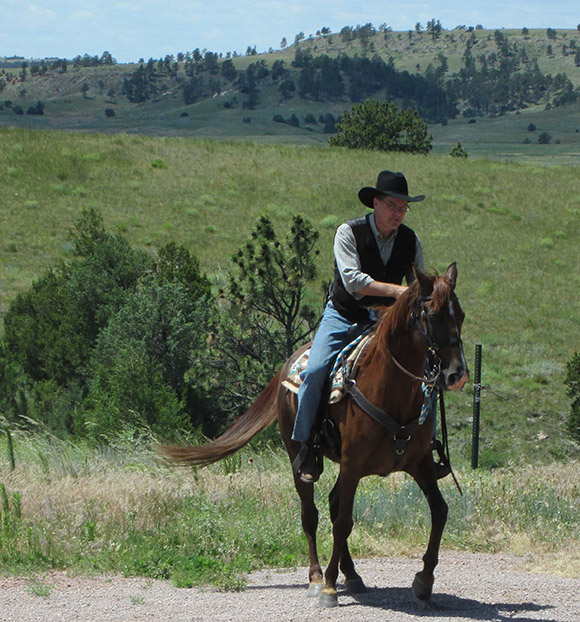
Taylor hopes to be riding his horse, Ribbon, a Tennessee walker, in the Black Hills like he used to after a hip replacement.
Janus, an ancient Roman deity, was a two-faced critter. One face looked to the future, one to the past. The Romans associated Janus with doorways, beginnings, transitions, passages, comings and goings. The month of January was named for Janus in both the Julian and its later transmogrification, the Gregorian calendar. Most of the world has used the latter to mark the passage of time since the late 16th century. So, looking back and looking ahead seems appropriate this time of year.
Looking Back
Considering the past year, I’d have to describe most of it as pretty darn good.
One of the best things was FUR-FISH- GAME’s 100th anniversary celebration in 2025 – something I was particularly proud to be a part of. I truly enjoyed rooting through early issues to select the articles we featured each month, as well as putting together a dozen magazines that featured past and present. Hopefully you all enjoyed that as much as we did.
Recalling some of the other highlights of the past – my calendar runs from hunting season to hunting season – makes me smile. There’s Willa and Ellen, my English setters, coursing through a northern Meade County, South Dakota, sharptail covert last January. I see them working sharptail scent in a CRP field adjacent to a cornfield – winter food source – then both girls locked on point, a trio of sharptails flushing in front of them, one falling when my new Dickinson side-by-side barks. Willa picks it up and comes running back to me, to deliver the bird. Oh, happy day!
That CRP field held more sharptails than I’d seen in half a dozen sharptail coverts five years earlier. It was a bounty I won’t forget.
There was that big whitetail buck, his rack noticeable at more than 1,000 yards, trotting across the big valley on state school ground during last fall’s deer season. I marked him at 264 yards and missed him twice before he hopped the fence between public and private ground. I won’t forget him.
There’s young Willa and 13-year-old Ellen hunting in the September sharptail season, in another favorite covert, the bottom of it covered in snowberry bushes, ripe with fruit. I’ll always see Willa this way, coursing the prairie, joy flowing from her so thick you could feel it 75 yards away.
A June return visit by Phil Goes and his family – Huck, Hugo and wife Elizabeth – was very enjoyable. No grasshopper scourges this summer for the boys to catch, but we had fun. Hugo was gussied up in full cowboy attire, hat, a cap sixgun, holster, chaps, even a duster. The works. We didn’t get to fish this year, but hanging out with the Goes clan is always fun.
Our garden went great guns this summer. With no grasshopper scourge to eat down the green beans from 2-foot tall bushes to stubs in a day-and-a-half’s time, it was a great garden year. Frequent rainfall resulted in healthy crops of turnips, chard, string beans, jalapeno peppers, tomatoes, and a bunch of different summer and winter squash.
We also completed a much-needed front porch three-tier deck rebuild and entrance revamp. I felt trepidatious about starting it. I’d never done one before, and with the spirit of my father watching over my shoulder – he could build practically anything and do it perfectly the first time – I worried I’d mess things up. But I didn’t.
With some technical assistance from Menard’s and my kind neighbor, Jon Baum, Nancy and I designed the revamped deck, ordered the lumber, put it together and ended up proud of what we’d accomplished.
Nancy also wanted a wildflower garden. So, we incorporated it into the deck and front porch plan. I moved a rusted-out stock tank from behind the barn to in front of the deck, then moved a bunch of huge, 75- to 100-pound steppingstones that led into the previous deck and front porch to form a semi-circle stone walkway around the deck and stock tank. I filled the tank with topsoil. Come spring, the tank will host a slew of annual wildflowers. Other flower beds, outside the stones around the porch and between the loop of the stone walkway, will grow perennials. It should be very pretty.
Yet 2025 was no walk in the park. We experienced tragedy and hope all mixed together in the flow of time.
The tragedy was losing Willa in late June. She was 3 years old and just blossoming into a fine bird dog. Somehow, she got hold of and ate what looked like a furniture pad disc with sharp edges. As it worked through her intestines, it tore her up inside. She was the first English setter I’ve owned who passed away before reaching age 10, and I’ve had English setters since 1987.
Due to severe arthritis in my right hip, I could only do a couple short, half-hour, horse rides this summer. I missed long trail rides. This was the trigger to pursue hip replacement surgery this winter. Other than yanking wisdom teeth, I’ve never had a surgery, and that’s kinda of scary.
Another tragedy, at least from my perspective, especially when you’re trying to start an English setter puppy, was how empty my sharptail coverts were this fall. South Dakota’s Game, Fish and Parks Department’s touted sharptail numbers based on 2024’s harvest figures. They were quite good.
Heading into September, I believed sharptail numbers should’ve been good. There were plenty of birds early in 2025. A wet spring and summer created plenty of cover, also insects for growing chicks. Yet sharptail numbers were at most a fraction of what I saw last fall. And it wasn’t just one or two places, but all across my western South Dakota coverts.
Deer season was also a mixed bag. I tagged a 4 x 4 whitetail buck after spotting him chasing a doe in 100-yard loops on hillside about a mile away on public land. I went after him. When he pushed the doe up over the hill, I had a good chance of catching them. After cresting the hill, I spotted the buck lying in a patch of snowberries. My Model 70 .25-06 shooting 100-grain Barnes TSX bullets took him down.
With a doe tag to fill in a closer-to-home unit, I hunted the state school land where that big buck was last fall. Thanks to warm temperatures, deer didn’t need to feed in the harvested beans that covered much of this area. So, it was slim pickings on does. When I finally found one, she was being courted by a buck. He looked like the son of the buck I'd missed last year.
I made a stalk on the pair, got within about 400 yards, then crawled 20 yards at a time to get closer. When I thought I was close enough, my old Bushnell rangefinder said 251 yards. But looking at those deer through the scope, they couldn’t have been 250 yards, more like 300, maybe 350. I couldn’t get into the scope quite right lying prone, so I extended the bipod legs, sat up and tried to hold the crosshairs steady. When they sort of settled on the doe’s chest, I squeezed the trigger.
I heard a bullet strike, but watched the doe and buck bolt. My bullet hadn’t hit vitals. It took three more stalks across about a mile of the public area and a final 300-yard plus shot to finish her. I wasn’t very proud of how this came about, but glad I could complete the mission.
Elk season proved more disappointing. I drew a late season cow tag for the Pringle area, the Black Hills self-proclaimed “elk capital.” I’d hunted and rode horses in this area extensively, saw elk often and had a good sense of where they probably were. Yet five days of hunting passed without seeing a single elk. I saw fresh sign in the snow, droppings, tracks, but simply couldn’t put an elk in front of my rifle. Yet I was sneaking up on 20-yard does and spotting several very large-racked whitetail bucks bedded at 300 yards, so I clearly wasn’t spooking elk. I did see eagles and crows fighting, some coyotes, heard some gobblers coming off the roost, and being in the Black Hills is always a fulfilling experience.
Looking ahead
There’s late season sharptails. Theo, Ellen and I will be bird hunting throughout January, if the weather allows. I can only hope some of the winter coverts will produce more than what we saw in the fall.
They tell me I should be moving around pretty good 12 weeks after hip replacement, perhaps in time for spring gobbler season. I hope to come out better than I went in. Hearing a big old Merriam’s gobbler sounding off in one of my favorite hunting spots while elk hunting prompted a goal. I’ve crossed swords with those turkeys several times but have yet to shoot a longbeard there. I plan on correcting that situation with a new hip capable of boogeying up the mountainside this spring.
And by summer, I plan on riding my horses on Black Hills trails like I used to. June is a wonderful time to do this in the Hills. It’s relatively cool, and the scent of greening grass and ponderosa pines wafting gently through the forest along a trail is intoxicating. I absolutely love it.
Chores will also occupy a good bit of the summer. There’s a backdoor deck and backyard fencing project to complete, a round ring in the pasture to fix. (Wet weather last summer caused a pile of rotting boards to fall apart in the round ring, they need replaced.) I’ll need to rotate horses into pastures and do other work.
There are some mountains to climb in my future, but once on top, I believe I’ll be seeing forever.
May your coming year be fruitful and full of wonderful outdoor experiences.
Happy New Year! And Thank You!
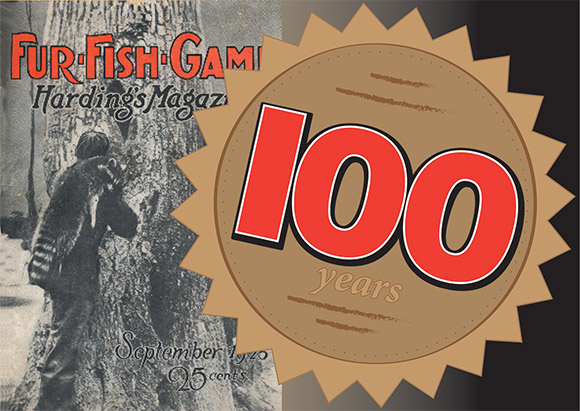
Wow. What a year it's been. Thanks to all of you reading this humble little magazine we've made it an unprecedented 100 years. That's 100 years of uninterrupted magazines, printed on paper, and mailed out every single month, all dedicated to practical outdoorsmen. To this day we remain a small, family-owned business. It gets more challenging every year, with skyrocketing costs, but your dedication has kept us here. So, again, thank you. Here's to not changing a thing in 2026.
-Eric Schweinhagen, Publisher
Snowmobile Safety
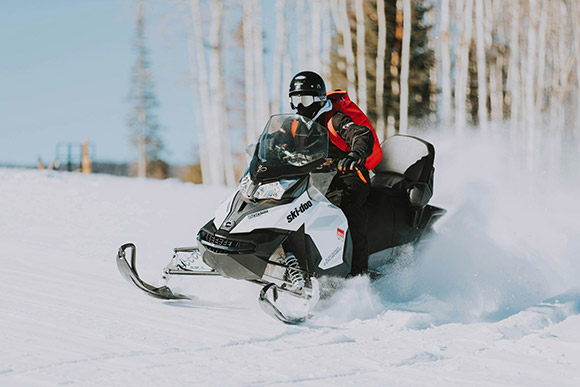
Minnesota is urging snowmobilers to ride safely have their machines registered properly and use updated trial conditions. Photo: Nate Johnston/Unsplash
As snowmobilers prepare for the upcoming riding season, the Minnesota Department of Natural Resources (MDNR) reminds riders to focus on safety, proper snowmobile registration and trail conditions. Snowmobile riding season starts when a number of conditions are met: The ground must be frozen. Where trails cross wetlands, 15 inches of ice are required to support the weight of trail groomers. And about a foot of snow cover must be on the ground to allow for trail packing and grooming. Trails must be cleared of fallen trees, and signs put in place and gates opened. (To check on trails, visit MDNR’s mndnr.gov/snow_depth.) Nearly all of Minnesota’s 22,000-plus miles groomed snowmobile trails are maintained by local snowmobile club volunteers, not MDNR. Many clubs post conditions of local trails online. (Locate clubs at mnusa.org.) Snowmobiles must be registered and in good operating order. State law requires a snowmobile safety certification for residents born after December 31, 1976, but MDNR urges all riders to complete a safety course. Snowmobilers should also be weather aware and skip riding in adverse conditions. Always stay on designated snowmobile trails. Venturing off trails can result in accidents, and landowners can revoke right-of-way permission for trail riding on their property. Never drink and ride – alcohol is a factor in more than 60% of fatal snowmobile accidents. Always wear a quality DOT-approved helmet and facemask. An interactive snowmobile trail map is available via mndnr.gov/snowmobiling. Minnesota’s 2025 snowmobile regulations are available at mndnr.gov/regulations/snowmobile.
Missouri Honors Conservationist
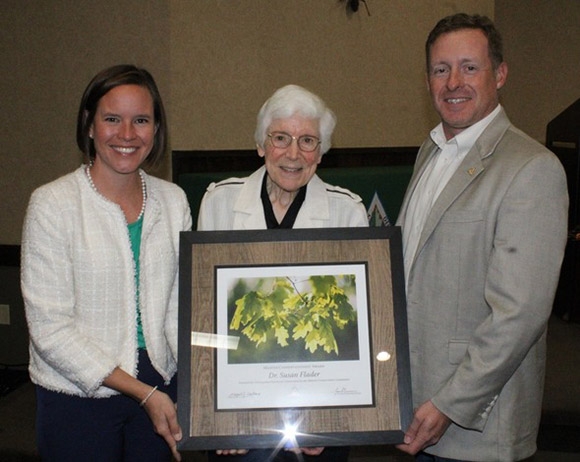
Missouri recently honored Susan Flader, of Columbia, for her lifetime commitment to conservation.
The Missouri Department of Conservation (MDC) and the Missouri Conservation Commission recently honored Susan Flader, of Columbia, for her lifetime commitment to conservation. Flader was given the MDC’s Master Conservationist Award. The award was created in 1941 to honor living or deceased citizen conservationists. Flader is a professor emerita of American western and environmental history at the University of Missouri-Columbia. She has written extensively about Aldo Leopold – considered by many to be the father of wildlife ecology and modern conservation – and served as board chair of the Leopold Foundation. Flader is also a founder and past president of the American Society for Environmental History and the Missouri Parks Association (MPA). She combined her academic work with conservation advocacy, taking on leadership roles in organizations such as the MPA and teaching at the university. Flader's research focuses on the relationship between people and natural ecosystems, and the evolution of conservation thought and practice. Key areas of her research include Aldo Leopold and ecological thought, Missouri conservation history, public lands and park preservation and conservation policy and water resources.
Some Ohio Deer Tags Reduced

Ohio’s Department of Natural Resources (ODNR) reduced the bag limit to one deer in Athens, Meigs, and Washington counties in response to an outbreak of Epizootic Hemorrhagic Disease (EHD). Photo: Mister A/Unsplash
The Ohio Wildlife Council received a proposal for new whitetail deer hunting limits in Athens, Meigs, Morgan and Washington counties last fall. The Ohio Department of Natural Resources (ODNR) Division of Wildlife proposed reducing the bag limit to one deer in Athens, Meigs, and Washington counties in response to an outbreak of Epizootic Hemorrhagic Disease (EHD) in these locations. In Morgan County, the bag limit was proposed to be reduced to two deer (from three) because of the same EHD outbreak. ODNR previously proposed reducing the deer bag limit in Athens, Meigs, and Washington counties from three deer to two. In response to public comments received during a 30-day window, the proposal was revised to reduce the bag limit in those counties to one deer. The Ohio Wildlife Council approved this reduction, which remains in place until the close of the 2025-26 deer hunting season on Sunday, February 1, 2026.
West Virigina Monster Trout
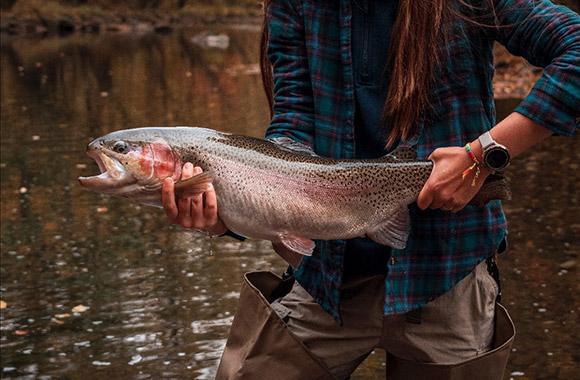
West Virginia stocked a bunch of trout last fall, including 6,500 pounds of 3- to 6-pound monster trout.
The West Virginia Division of Natural Resources (WVDNR) began its fourth annual Monster Trout Contest this fall. In October, WVDNR stocked 40,000 pounds of trout weighing 1-2 pounds and 6,500 pounds of monster trout weighing 3 to 6 pounds at 41 lakes and streams around the state. As part of this year’s Monster Trout Contest, WVDNR fisheries staff tagged 100 monster trout with a bright pink tag. Anglers who caught one of these fish, submitted a photo with their catch and provided proof of the tag number online were entered into a giveaway drawing. One lucky angler won a weekend-long cabin stay at a West Virginia State Park and four anglers won a Bass Pro Shops prize package. The contest ended in November, but some of those big trout are still swimming in state waters. Visit WVfish.com.
Illinois Sets Record Youth Deer Take
.jpg)
Illinois youth hunters set a new harvest record. Photo: Mister A/Unsplash
Illinois youth deer hunters set a new record for the season, harvesting a preliminary total of 4,714 deer October 11 through 13. Top harvest counties were Randolph, 259; Pike, 164; Adams, 155; Jefferson, 155; and Marion, 135. Comparatively, youth hunters took 4,097 deer during the 2024season.
Aspen Cutting to Benefit Wildlife

Michigan intends to speed up aspen harvests in a 30-square-mile area to benefit elk, deer and other wildlife that depend on aspen for food and cover.
Elk, deer and other wildlife will benefit from aspen clearcutting in Michigan’s northern Lower Peninsula, according to the Michigan Department of Natural Resources (MDNR). MDNR intends to speed up aspen harvests in a 30-square-mile area. The change will benefit elk, deer and other wildlife that depend on aspen for food and cover. Aspens are a resilient tree that regenerate naturally from underground shoots, or root suckers, without the need for replanting. Elk and deer browse on young aspen throughout the year, but primarily during fall and winter, when other food sources become scarce. Aspen stands were not regenerating in core elk range to meet MDNR’s standards. The accelerated cutting will take place in nine units, including the Atlanta Unit, in neighboring Pigeon River country and within the two state forest management units in Montmorency and Otsego counties. Clearcuts originally planned over the next 10 years will be grouped into a shorter time frame to better support forest regeneration and elk habitat. Plans for the clearcuts and other forest management practices are available at Michigan.gov/ForestManagement.
Wisconsin Bear Season Results
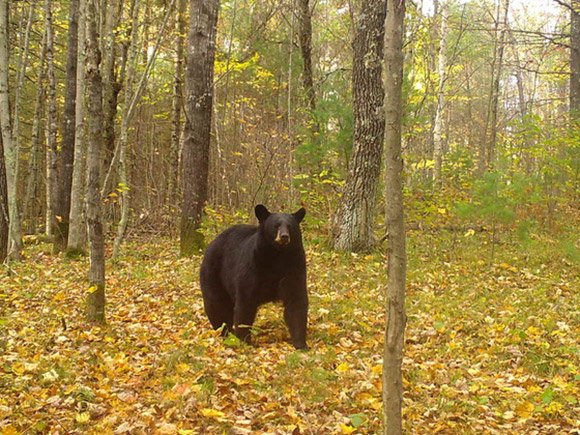
Wisconsin bear hunters tagged more than 3,700 bears during the state’s bear season.
The Wisconsin Department of Natural Resources (WDNR) tallied preliminary results for the 2025 bear season. Bear hunters harvested 3,724 bears during the 35-day season, putting this season on par with the five-year average of about 3,800 bears annually. This year's harvest was slightly below the overall harvest target of 4,075 bears, but within the expected range of harvest. Field reports were variable, according to Randy Johnson, WDNR large carnivore specialist. Some hunters had one of their best years bear hunting, others were challenged by abundant acorns and corn and saw fewer bears at their baits. Below-average temperatures early didn’t help, same for above average temperatures later in the season, Johnson noted. Both can affect bear activity. Overall, hunter success rates, 28%, was slightly below average. The five-year average success rate is 32%. A total of 13,110 bear hunting licenses were issued through the license lottery system. More than 146,000 people applied for a bear tag. Wisconsin’s thriving bear population is estimated to be 23,000 bears, with a range covering more than half the state. Visit the WDNR's bear hunting webpage at https://dnr.wisconsin.gov/topic/hunt/bear.
CWD and Iowa Deer
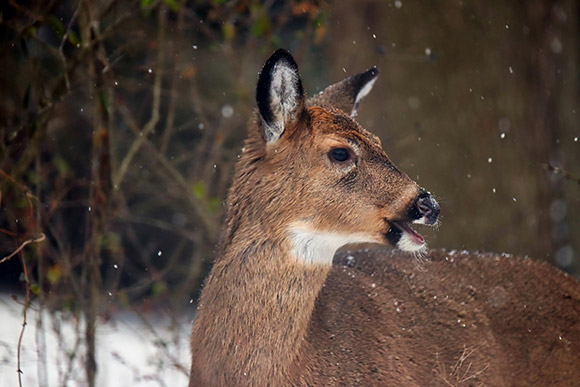
Iowa is monitoring CWD, especially outside of hunting season, so the Iowa Department of Natural Resources can implement management actions early. Photo: Thomas M. Evans
Deer tags had not yet gone on sale when Iowa received its first positive case of chronic wasting disease (CWD) in 2025’s CWD survey – a buck from Lucas County. Iowa Department of Natural Resources (IDNR) has been sampling deer from every county, every year since 2002. While hunting season is when most samples are collected, collecting samples year-round helps avoid gaps in CWD surveillance. CWD is an always fatal disease affecting deer, elk, moose and caribou. It is spread through direct contact and via blood, urine and saliva left on the landscape. Monitoring CWD, especially outside of hunting season, is important because it allows IDNR to implement management actions early, noted IDNR biometrician Tyler Harms. This gives IDNR its the best chance to slow the spread of CWD. Initially, IDNR targeted high risk areas – the northeast region, close to CWD positives in Wisconsin and Illinois. “Hunters care, they’re passionate,” Harms said. “They want to do what they can to slow the spread of the disease.” IDNR wants to keep hunters informed about CWD, so they can make decisions for themselves, including if they want to get their deer tested. Harms, along with other IDNR staff and Iowa State University’s (ISU) Extension, have been holding classes, mostly in areas impacted by the disease, to educate a core group of interested hunters who will help to keep other hunters and landowners informed on the disease and to reduce misinformation. Visit https://naturalresources.extension.iastate.edu/programs/chronic-wasting-disease-ambassadors.
Fix Our Forests Act
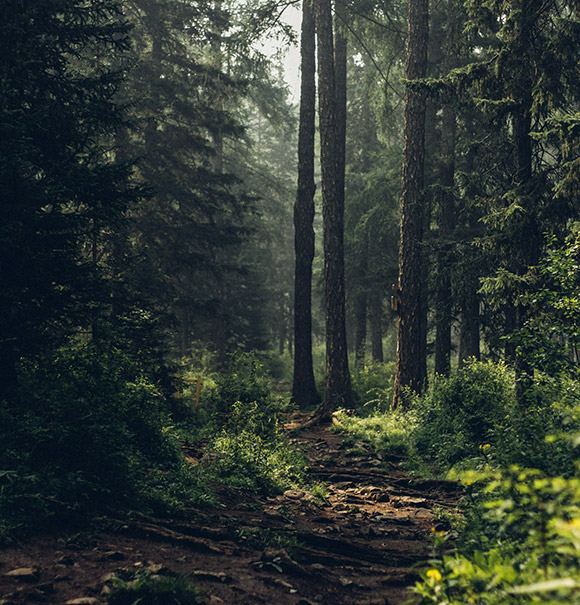
The Fix Our Forests Act would provide a comprehensive approach to address the nation’s forest health and the wildfire challenges. it would allow the U.S. Forest Service to accelerate active forest management in national forests, reducing the risk of severe wildfires, improving big game habitat, and creating jobs in rural communities. Photo: Degleex Ganzorig/Unsplash
Conservation groups, including the Theodore Roosevelt Conservation Partnership and the Boone and Crockett Club, are applauding a bipartisan-supported U.S. House of Representatives’ bill, H.R. 471, the Fix Our Forests Act. The bill seeks to accelerate forest management and restoration, improve wildfire resilience, and expand collaboration and innovation. The House approved the bill, and as of mid-December. It is now before the U. S. Senate’s Agriculture Committee, where significant debate is likely. The Fix Our Forests Act was introduced by Rep. Bruce Westerman, of Arkansas and Rep. Scott Peters of California. It passed the U.S. House with a strong bipartisan vote The bill provides a comprehensive approach to address forest health and the wildfire challenges. It would allow the U.S. Forest Service to accelerate active forest management in national forests – reducing the risk of severe wildfires, improving big game habitat, and creating jobs in rural communities. This includes harvesting trees, thinning dead and dying trees, creating fuel breaks, prescribed and managed burns, and creating defensible spaces against forest fires. All are effective tools to reduce wildfire threats and improve wildlife habitat. The legislation also bolsters the use of replanting after wildfires or other extreme events, and supports ecosystem and habitat restoration across Western forests, and in the priceless white oak forests of the East. If approved, the bill would also implement restoration projects, expand collaborative tools and improve coordination between local, state, federal and tribal partners. In addition, the bill recognizes that projects to restore and improve floodplains and wetlands can demonstrably reduce wildfire risk to downstream communities, including the long-term impacts wildfires can have on valuable drinking water supplies for rural and urban populations.
California, Washington Bust Animal Parts Traffickers

California and Washington state have busted illegal wildlife traffickers recently.
Two states, California and Washington, recently busted illegal wildlife traffickers. The California Department of Fish and Wildlife’s (CDFW) Special Operations Unit (SOU) uncovered extensive evidence linking a business in Los Angeles to suspected trafficking of animal parts, including rhino horn and elephant ivory. Investigators discovered what appeared to be at least nine rhino horns, thousands of pieces of elephant ivory, several large, intricately carved tusks and a sea turtle shell. The case was uncovered last fall. CDFW encourages the public to report wildlife trafficking and poaching activity via CalTIP by calling (888) 334-CALTIP (2258) or submitting anonymous tips via text toTIP411 (847411). In Washington, a Department of Fish and Wildlife (WDFW) police investigation into illegal elk trafficking resulted in a guilty verdict for a Yakima County resident. Braden F. Tahkeal, 52, was sentenced in October to one felony count of unlawful wildlife trafficking. Tahkeal received jail time and fines and restitution to include $2,000 to the Confederated Tribes and Bands of the Yakama Nation and $5,000 to WDFW. A 2020 tip implicated Tahkeal in unlawfully trafficking more than 42 elk. Tahkeal was selling trafficked elk in Vancouver and Portland, Oregon, through online black-market chat groups. Undercover officers investigated and bought elk from Tahkeal in central Washington. Black market prices can range from $800 to $1,000 for one elk, with a large trophy bull’s antlers selling for much more.
UPCOMING EVENTS
New York State Trappers’ Association
Two New York State Trappers’ Association affiliates, The Foothills Trappers and Fulton Mongomery Trappers, will hold their annual fur auction January 3, 2026, at the 4-H Building located at 556 Middleline Rd., in Ballston Spa, New York. Call Neal Sowle (518) 883-5467 or Paul Johnson at (315) 867-6565 for information.
Pennsylvania Trappers’ Association
District 10 of the Pennsylvania Trappers’ Association will hold a fur sale, January 17, at
The Stockertown Rod and Gun Club, located at 206 Lefevre Road, in Stockertown, Pennsylvania. Doors open at 8 a.m., the sale starts at 9 a.m. Contact Bob at (610) 759-9203 for more information.
Indiana State Trappers’ Association
The Indiana State Trappers’ Association (ISTA) 2026 Fur Sale will hold two fur sales in 2026. The first will be held January 31, 2026, at the Selvin Community building, 11900 Yellowbanks Trail, in Dale, Indiana. (Note the change of location.) The second will be held February 14, at the Miami County Fairgrounds, 1029 W 200 N, in Peru, Indiana. You must be an ISTA member to sell furs. Lot numbers can be purchased prior to the sale, and buyers will be coming in from several states. Both events include food, trap raffles and 50/50 contests. Doors open at 8 a.m. Sales begin promptly at 9 a.m. local time. Dale is in the Central Time Zone and Peru is in the Eastern zone. For more information, call or text Byron Tiede (219) 863-3803.
Illinois Trappers’ Association
Illinois Trapper’s Association will host a fur sale on February 21 at the Krile Auction house in Strasburg, Illinois. Doors open at 7 a.m., all skinned and dry goods are welcome. Rare or unusual specimens suitable for taxidermy are allowed on the carcass. Visit www.illinoistrappersassociation.com for more information.
New Mexico Trapper’s Association
The New Mexico Trappers’ Association will hold a fur auction and rendezvous March 5 – 8 at Mountain View Christian Camp, in Alto, New Mexico. For more information, contact Shelly (575) 649-1684 or email gypsytrapper@yahoo.com.
West Virginia Trappers’ Association
The West Virginia Trappers’ Association will hold their annual Spring Fur Auction March 6 - 8, 2026 at the Gilmer County Recreation Center, 1365 Sycamore Run Road, in Glenville, West Virginia. Vendors will be present throughout the weekend. Consignment for finished fur, roots, deer horns etc., begins at 9 a.m., Friday, March 6, and on Saturday, March 7. The fur auction will be held Sunday at 1 p.m. Ginseng will be sold to individuals outside, not through the WVTA auction. Admission is free, all are welcome. Contact Jeremiah Whitlatch (304) 916-3329 or visit www.wvtrappers.com
Virginia Trappers’ Association
The Virginia Trappers’ Association (VTA) will hold its Eastern fur sale on March 14, at 12400 Herndon Rd, in Spotsylvania, from 7 a.m. until finished. Inspections begin at 8 a.m., the auction starts at 9 a.m. Same day registration is available. Also, on June 5 and 6, 2026, VTA will hold its annual Rendezvous at the Rockingham County Fairgrounds, 4808 S. Valley Pike Rd., in Harrisonburg. Call or text Craig Kunkel at (540) 539-1409 for more information.
Connecticut Trappers’ Association
The Connecticut Trappers’ Association will hold a spring fur sale April 4, at the Tolland County Agricultural Center, located at 24 Hyde Avenue, in Vernon, Connecticut. Fur drop off is 8 a.m. to 11 a.m. CTA membership is not required to sell fur, and there is no commission. Buyers are welcome. Contact Cameron Kelsey (619) 997-2345 or Scott Kneeland (860) 234-3192.
Texas Trappers’ and Fur Harvesters’ Association
Texas Trappers’ and Fur Harvesters’ Association will hold their Spring Rendezvous April 24 and 25 at the Mashburn Event Center, located at 1100 7th NW, in Childers, Texas. Visit www.ttfha.com for more information.
Maine Trappers’ Association
The Central Maine Chapter of the Maine Trappers’ Association will hold its annual Spring Fur Auction April 26, at the Palmyra Community Center, 768 Main St., in Palmyra, Maine. Doors open at 7 a.m., the auction begins at 8 a.m. Maine wardens will be on site to tag furs. A 3% commission is charged. Contact Ted Perkins at (207) 570-6243.
Coming in our February 2026 Issue
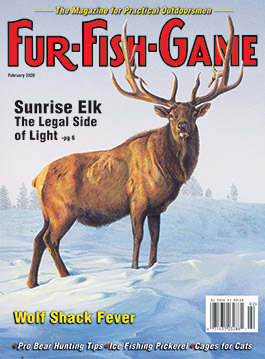
Features
• On The Legal Side Of Light - Noah Davis and his daughter Heather discover that waiting for the right moment to shoot has its own rewards.
• A Long Walk In The Wilderness - Lawrence Morgan must take his furs down the Yukon River to sell in mid-winter Alaska. Along the way, he has an unexpected adventure.
• Sucker Punch - Phil Goes and his sons, Huck and Hugo, go sucker fishing and find that sucker fishing sure beats being cooped up indoors.
• Wolf Shack Fever - Rachel Langley and her husband, Jake, spend five days in a wolf “shack,” hoping to encounter the ghost of the Canadian timber.
• A Guide’s Guide to Bear Hunting - Serge Lariviere shares a Quebec bowhunt with bear expert Ken Taylor and shares ideas on improving your hunts.
• Cages For Cats - Jason Houser tells how he uses live trap “cages” to catch elusive bobcats. It’s simpler than you might think.
Other Stories
• The Saga Of Ruby And Molly – Authur Good shares his recollections of two fine beagles.
• My First Year On The Trapline – Conor McKinley recounts the lessons learned during his first year of trapping.
• A Trapper’s Tools – Jim McCarrick looks at the tools a trapper will find useful.
• Trophies Are Relative – Landon Wardell discovers that tagging a muley spike buck offered him more satisfaction than some of the much larger bucks he’d taken.
• Backcountry Trout: Ice Fishing The Wild UP – Chris Schroeder shares tips for getting into Michigan’s Upper Peninsula and ice fishing for wild trout via snowmobile.
• The Last Day – Trevor J. Hubbs recounts the last day of his Wisconsin waterfowl season and how it takes real moxy to gut it out in the cold and ice for a modest reward.
• Cold - Trevor J. Hubbs shares a cold experience where hypothermia clouded his mind and could have cost him his life on his trapline.
End of the Line Photo of the Month
Jake Smith & Jack Lavery, Grayling, Michigan
Subscribe to this newsletter
Put Subscribe in the subject line and include your first and last name.
SUBSCRIBE TO FUR-FISH-GAME Magazine

